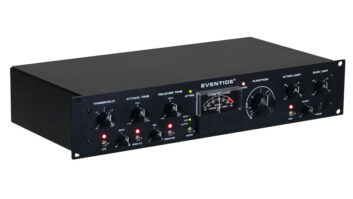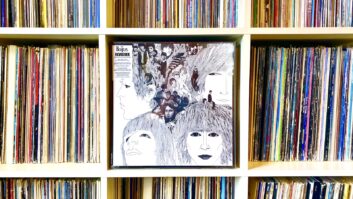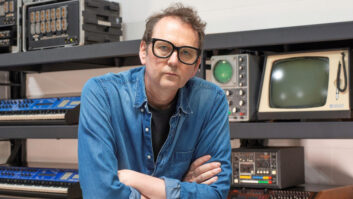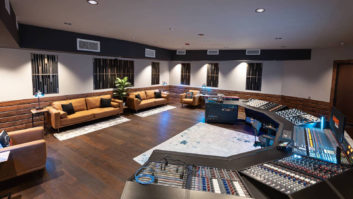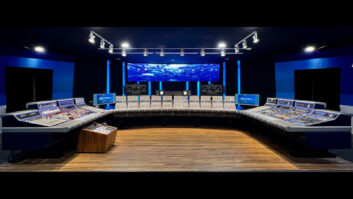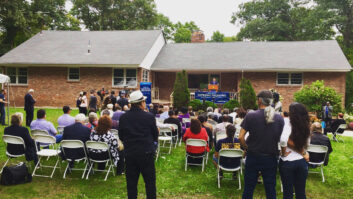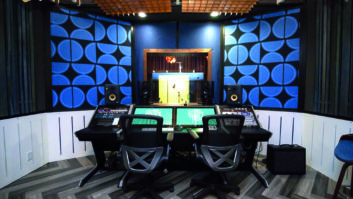After visiting Cerebrum, a New York City club that opened in 1968 and offered what was described as an “innovative immersive experience,” Jimi Hendrix decided to build his own club and sought out the designer. The project soon turned into a recording studio, Electric Lady, and the designer, John Storyk, a recent architecture school graduate, found himself propelled on a career path that would see him and his firm go on to design nearly 4,000 audio/video production, performance, education, house of worship and residential facilities worldwide.
Storyk and the partners and employees at WSDG – Walters-Storyk Design Group have spent the past year celebrating 50 years in business. “I have my first drawing, dated February 1969,” says Storyk of the Electric Lady Studio project, which took 15 months to complete.

Over the past five decades, WSDG’s projects have included New York’s Jazz at Lincoln Center; private production spaces for Jay-Z, Bruce Springsteen and Alicia Keys; commercial studios such as Jungle City in New York and The Church Studios in London; and broadcast facilities for CBS, WNET and Food Network.
The company has grown from a home-based business to a global network of offices in New York, Miami, Switzerland, Germany and Brazil, with representation in Spain, Argentina, Qatar, China, Mexico, India and the United States. And now, with a half-century in business behind him, Storyk, who turns 74 in May, has implemented a succession plan that will allow WSDG to continue for another 50 years.
Just don’t call it a retirement.

“I’m just involved in the 30,000-foot view,” he says. “I still work 50, 60 hours a week. I’m the lead designer on about 25 percent of the projects. I still review every design. I teach and I write. We have a research group that I’m very involved in on some issues you’ll hear more about in about six months. We’re releasing some pretty interesting analysis software.”
Storyk stresses, “I’m not even interested in retiring. I worked all these years to get pretty good at something, so what would be the point? The ‘R word’ does not work with me.”
The company today is a far cry from its beginnings, when Storyk was an aspiring music star making a living with carpentry work and a brief stint in an architect’s office. “If you were to describe to a 22-year-old—a sax and piano player, an architect out of Princeton, living in Greenwich Village in the summer of ’68—the life he would have over the next 50 years, and that [his legacy] would continue after he is no longer here, I would have said you were crazy,” Storyk says.
Related Stories from Mix:
• A Series of Fortunate Events: John Storyk on the Birth of Electric Lady, by Barbara Schultz, Oct. 1, 2013
• Eddie Kramer and the Early Days of Electric Lady, by Steve Jennings, Oct. 1, 2013
• John Storyk: Thirty Years of Studio Design, by Dan Daley, June 1, 1999

With Electric Lady barely underway, he was introduced to legendary artist manager and entrepreneur Albert Grossman through a mutual friend, a roadie with The Band. “The anthem is, make your first project famous,” laughs Storyk. He began designing Bearsville Studios in upstate New York for Grossman, accompanying him to the Woodstock festival in August 1969.
Through his wife at the time, Storyk also met two people planning the first recording facility in SoHo, Blue Rock Studios. “So before I finished Electric Lady, I had two more studios to do,” he says.
While building Electric Lady, he reveals, “Jimi came around one day and said, ‘I don’t like the doors or the square windows. Can we have round ones?’ These expensive acoustic doors and windows came out and—I can now tell this, 50 years later—went to Blue Rock.”
For a few years, Storyk lived with his first wife in Colorado, where they had a child, but they separated in 1973 and Storyk returned to New York City. “I was doing a lot of work for Albert, and not only did he give me a room at his 55th Street office, but he let me live in one of his houses in Woodstock. Albert was essentially a mentor and a friend.”
Grossman died in January 1986: “It was a crushing blow.” But a new chapter was beginning. A couple of months earlier, Storyk had met Beth Walters, an interior designer, set builder and installation carpenter. “She arrived with a six-month-old baby; we raised him and had another a few years later. By that spring, we formed Walters-Storyk Design Group.”
After a stint with homes and offices in New York City and upstate, they ultimately consolidated, constructing a 5,000-square-foot building in Highland, NY, that is still their office today. Clients didn’t care where they were; they just needed a phone number.
All the while, the firm was growing. Interns would come and go, but many stayed and are still with the company. Some interns returned to their respective countries and set up offices. “Those representation offices became real offices, and all of a sudden we had gone from four or five people in Union Square to 60 people in five offices over about 15 years,” he says.

With his 70th birthday on the horizon, Storyk started making plans for key WSDG team members to assume more control. “I still own half, but I don’t control it; we have a board. I’m not the COO anymore,” he says, noting that he never enjoyed that part of the job.
Related:
• Stitcher’s Flexible New Facility, by Steve Harvey, April 19, 2019
• Gimlet’s Podcast Studios Serve Up a Cocktail of Content, by Steve Harvey, Jan. 3, 2019
Sergio Molho, who joined in 1994 as founding partner of the Latin America office in Argentina, is now partner/director of business development and based in WSDG’s Miami office, with partner/art director Silvia Molho. Dirk Noy, who signed on as a WSDG intern in 1997, now heads the European office as partner/director of applied science and engineering, in Basel, Switzerland. Renato Cipriano, Brazil-based partner/director of design, has been with WSDG since 2000. Joshua Morris, who joined in 2005, is now partner/COO, and Nancy Flannery is partner/CFO.
“They were able to buy into the company at a very reasonable price. I lent them the money to buy into it. They paid me back and now they’re my partners,” says Storyk. “We’re blessed with an amazing staff.”
Additional leadership roles were awarded to key senior management personnel, including longtime project managers Romina Larregina, now director of production, Gabriel Hauser, now director of acoustics, and Matthew Ballos, who is now director of architectural technology.
As the celebration year draws to an end, don’t call this a 50th anniversary. “WSDG is going to last after me. We’ve got a lot of people who want to keep it going. We’re calling it the First 50 Years.”
WSDG – Walters-Storyk Design Group • www.wsdg.com

